If you’ve seen photos of La Push Second Beach, Washington and wondered how to get there – or how to make sure your visit is as magical as it looks – you’re in the right place.
The trail might be short, but if you don’t plan for the tide, the driftwood, or the crowds, you could miss some of the best moments.
I love Second Beach and I’ll share what I loved (the sea stacks here are some of the most stunning on the Pacific Northwest coast) and what I wish I’d done differently (like packing an extra layer – this coast gets chilly fast).
This is for travelers who want an easy hike with a huge scenic payoff, love photographing dramatic landscapes, or just want to spend a few hours soaking in ocean views that feel completely untamed.
Here’s a little teaser – if you time your visit for low tide, you’ll be able to walk out toward the sea stacks and explore tidepools brimming with colorful anemones and starfish.
In this complete guide, I’ll walk you through everything you need to know about visiting Second Beach – trail details, best times to go, what to bring, and insider tips that will make your trip unforgettable.
Let’s get started.
🛏️TOP HOTEL PICK: Check availability now
🚘FIND THE CHEAPEST CAR RENTAL: Search Discover Cars for the best deals
✈️FIND THE CHEAPEST FLIGHTS: Search Skyscanner for the best deals
🧳GET TRAVEL INSURANCE: Get insured with Travelex before you go
📱TAKE AN AUDIO TOUR: Buy an audio tour now

Table of Contents
Basic Information about Olympic National Park Second Beach Trail Washington
ℹ️ Distance: 0.7 miles walk each way
ℹ️ Type: Out and back
ℹ️ Elevation change: 80 feet gain and 100 feet loss on way to beach
ℹ️ Time: 20-30 minutes each way
ℹ️ Difficulty: Easy – Moderate
ℹ️ Trailhead: Second Beach Trailhead on La Push Road
ℹ️ Highlights: Coastal forest; beautiful beach with driftwood and sea stacks offshore
ℹ️ Fee: There is no special trail fee and you don’t pass through any entrance station to enter Second Beach, so you can visit Second Beach for free.
However, if you are going to enter other sections of Olympic National Park like Sol Duc, Hoh Rain Forest and Hurricane Hill, you will need to pay the Olympic National Park entrance fee.
Buy it online or, if you are planning to visit more than just Olympic National Park this year (Mount Rainier National Park and North Cascades National Park are both close), it can be great value to purchase an America The Beautiful pass.
ℹ️ Operating Hours and Season: Open year-round
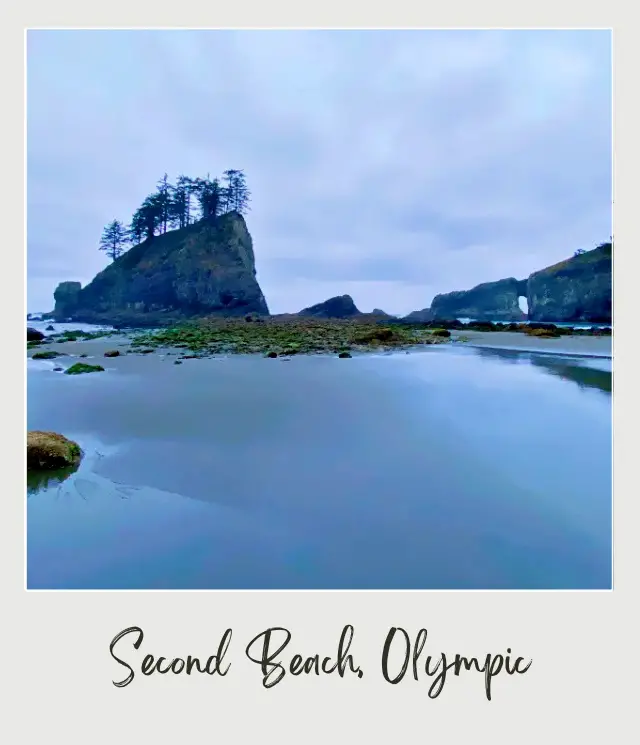
Subscribe to daily national parks planning tips, travel inspiration and trip ideas and get instant access to the free PDF of the
La Push Second Beach, Washington State: Complete Guide
Second Beach Washington Map
You can use this Second Beach Olympic National Park map – it’s perfectly sufficient for this hike, which is along a clearly marked trail to the beach and back.
However, if you’re going to be doing more hiking in Olympic National Park, this map won’t be enough and it’s worth getting a National Geographic topographic hiking trails map of Olympic National Park before you go.

Description of Second Beach Trail, Olympic National Park
The Second Beach hike has some up and down sections and a steep descent to the beach near the end.
The trail starts at the northern end of the parking lot. There is a port-a-potty by the trailhead.
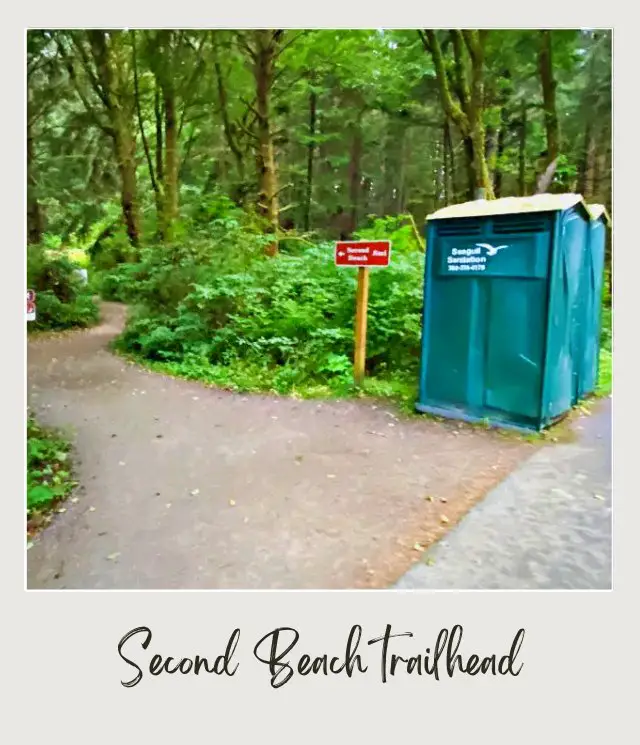
The trail starts very wide and mostly flat and is very easy to follow. It passes a moss-covered kiosk and then heads slightly downhill. It soon passes a chain wire fence and private access gate to the Lonesome Creek Hatchery, which is managed by the Quileute Fisheries Department.
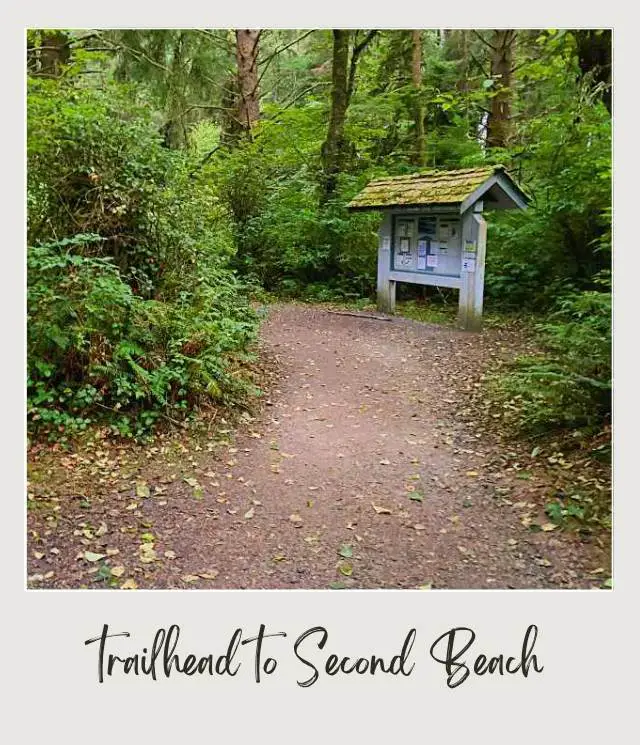
Although I thought this was a pretty inauspicious beginning, the trail soon gets better, as it heads deeper into the forest. The trail heads slightly downhill and crosses a small creek.
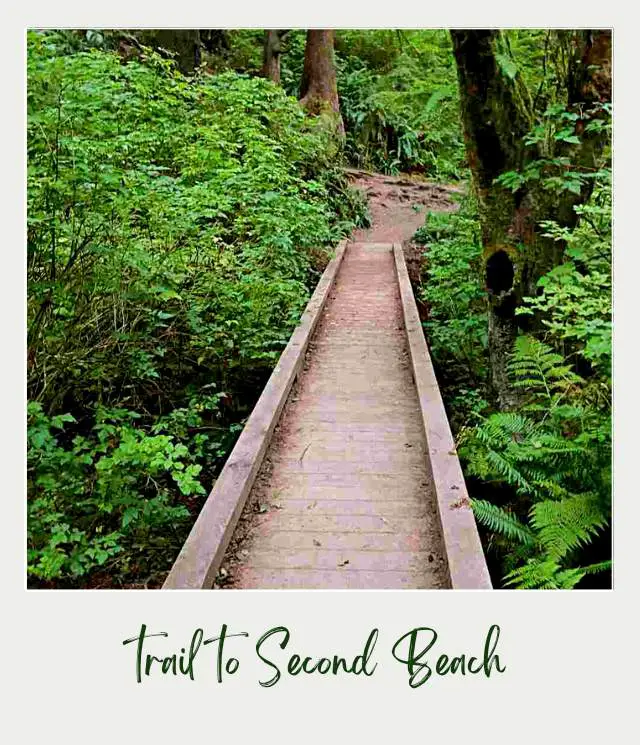
It climbs slightly then descends slowly through towering trees and past enormous ferns, winding gently around small marshes.
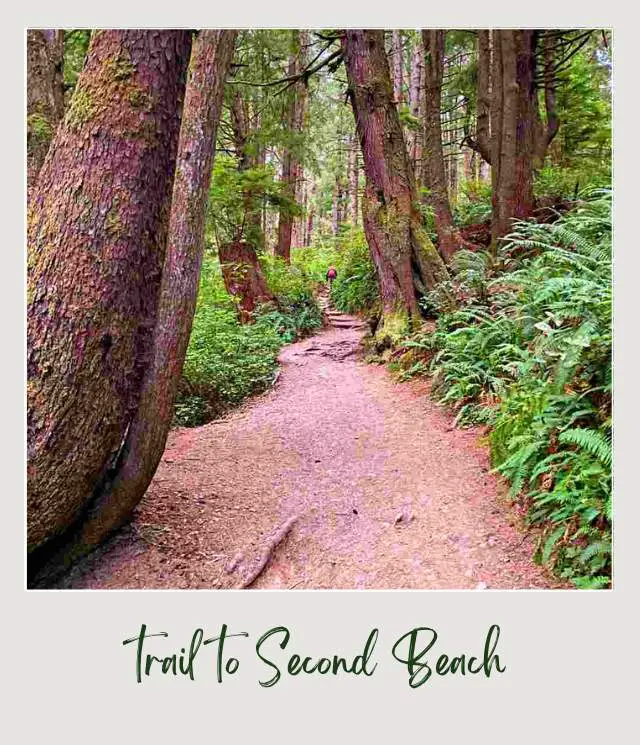
After about 0.3 miles, the it starts to descend even more, going down a series of gradual steps.
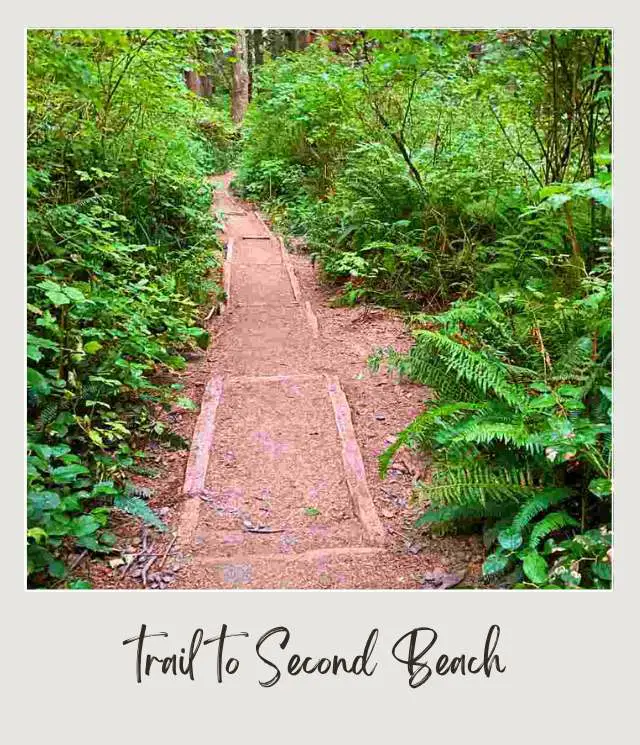
It then starts to switchback down a hill and the steps become steeper. I found them pretty easy to navigate, but this stepped section can be muddy and slippery in the wet season, so take care.
The steps are kind of steep but should be able to be managed by most people with reasonable mobility.

A couple of minutes before you arrive at the beach, you can see the ocean through the trees. It’s just another couple of minutes from there down to the sand.
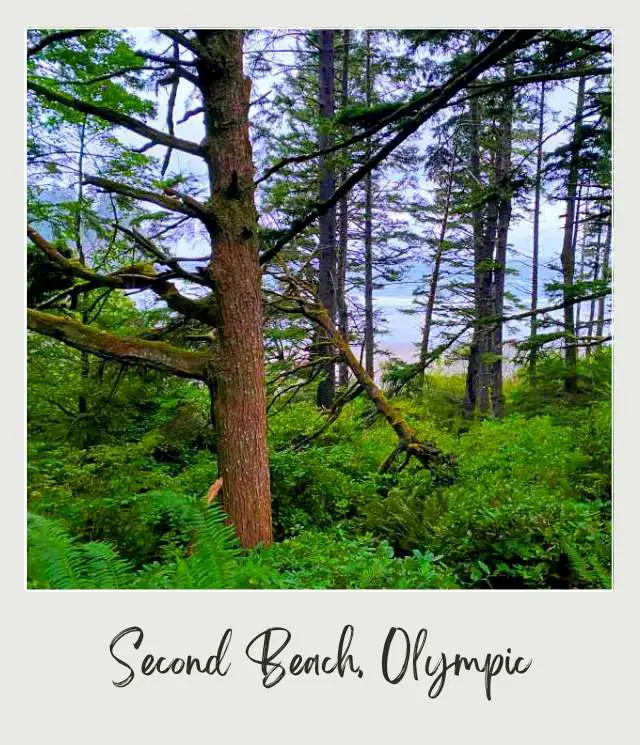
Description of La Push Second Beach, Washington State
When you arrive at the beach, there may be a pile of driftwood at the entrance that you need to climb over. I’ve been there when you could walk straight on to the sand, so be prepared for any conditions.
If there is driftwood, be very careful, as the logs can move and roll as you walk on them.

When you arrive at the beach, don’t forget to look back and notice the small circular sign indicating where the trail is, so that you recognize it when you’re ready to return.
Looking north, you’ll see a rocky outcropping with a natural arch carved in it. At low tide, you can walk along the beach to this area, where there are plenty of tide pools to explore. You can also see the natural arch up closer.

To the south is Teahwhit Head, which blocks access to Third Beach on the other side. Fewer people venture south, so you will often have the beach to yourself if you head in this direction. It’s about 1.5 miles along the beach to the headland.
Do NOT attempt to climb around either of these headlands as the rocks are very slippery and the tide is dangerous.
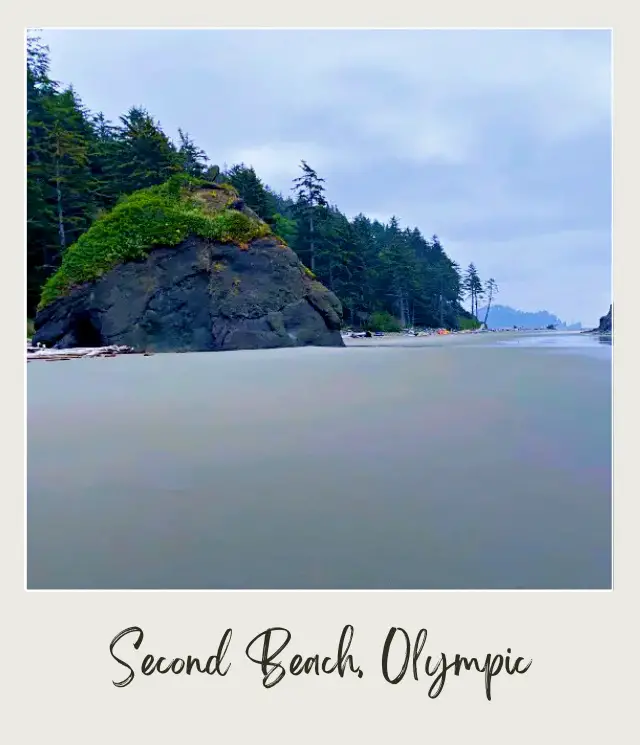
In front of you, is Crying Lady Rock and the Quillayute Needles archipelago.
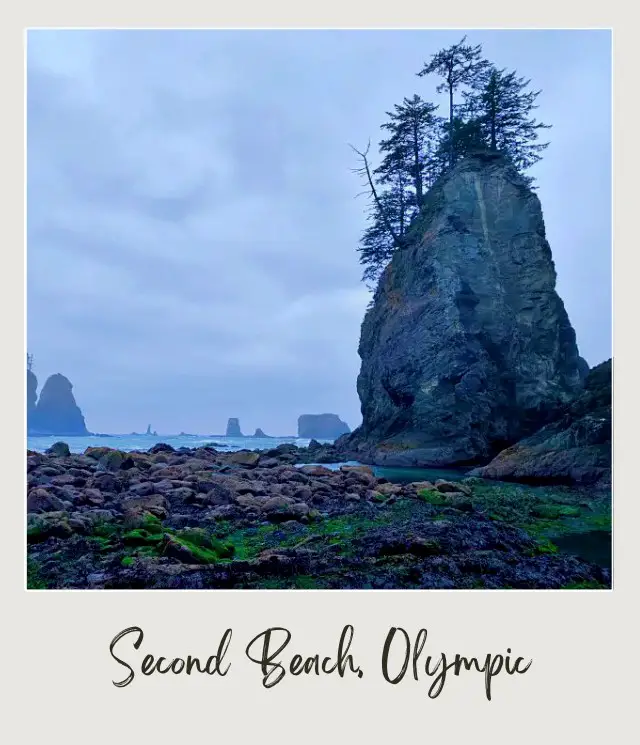
The Quillayute Needles are a group of several dozen small coastal islands that you can see in the distance. They are part of the Washington Maritime National Wildlife Refuge Complex, which protects more than 870 islands and reefs and is home to an estimated 800 sea otters. There are more than 14 species of seabirds, sea lions, harbor seals and sea otters on the Quillayute Needles alone.
Sea otters off the north American west coast were slaughtered to almost complete extinction by 1911. This is when hunting was made illegal.
It wasn’t until the late 1960s when sea otters from Alaska were re-introduced along the Washington and Oregon coast that numbers slowly rebounded. Keep a look out and you may see some from the beach.
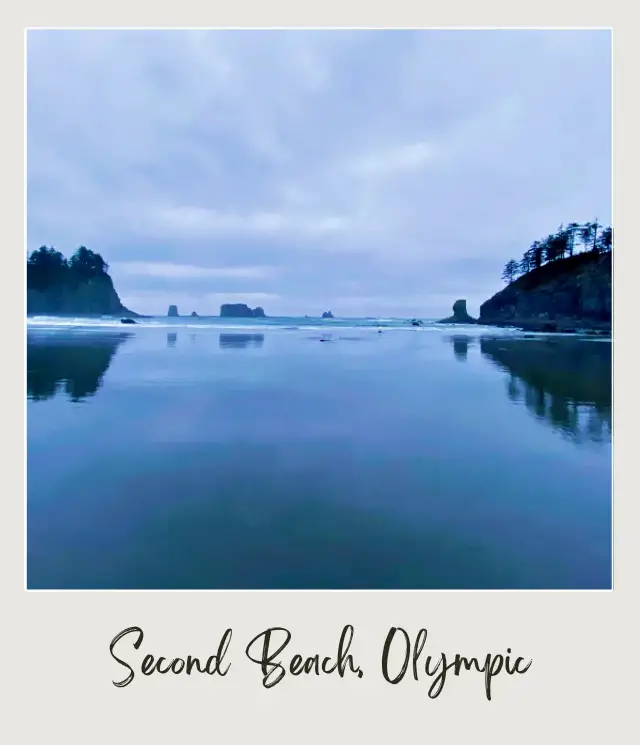
There are several fantastic sea stacks at Second Beach. Perhaps the most famous is Crying Lady Rock. At low tide, you can walk out to it, though be very careful not to get caught by the incoming tide. The rock is allegedly shaped like a woman’s face and water runs down the side of the rock, hence its name. You can decide for yourself if it looks like a crying woman’s face or not.
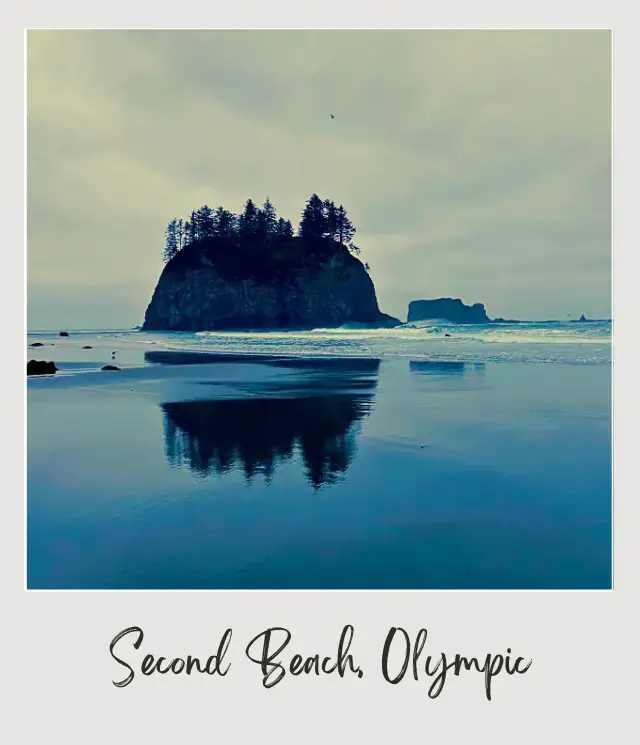
There are several other iconic sea stacks off Second Beach. Supposedly you can climb to the top of the sea stack to your left when you first arrive at the beach, though I’ve never tried this.
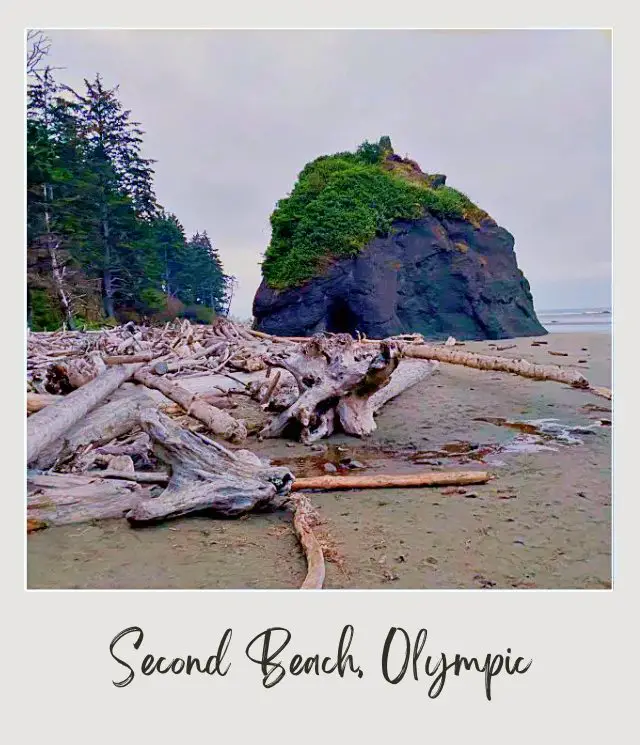
At low tide you can walk behind the largest sea stack where there is another sea stack behind it.
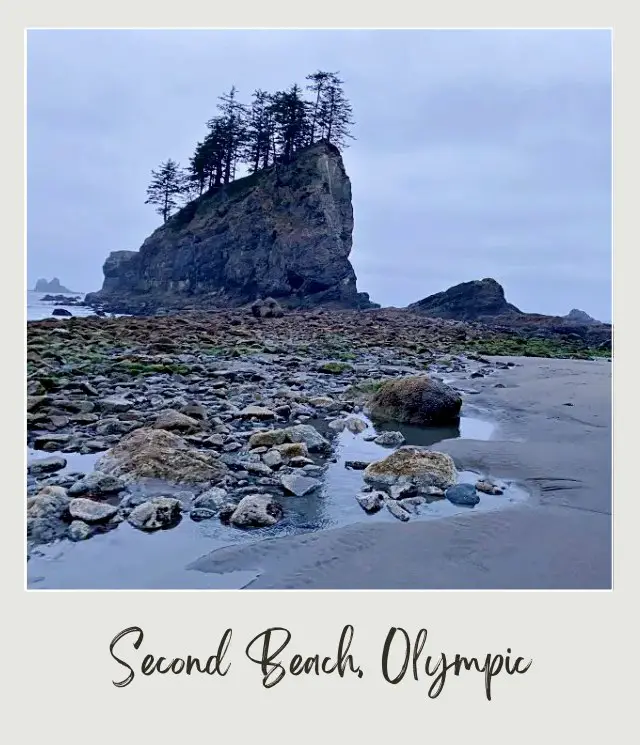
Learning all about Second Beach is actually a great thing to do, because it will make your trip there so much easier and more enjoyable.
However, it’s just one of the many amazing areas to visit in Olympic, and it can be really difficult to know what they all are and how to combine them all for your trip.
As you can see, there’s a lot to know about just this one attraction in the park. It’s a lot to coordinate all the things to see and do in Olympic into an itinerary that actually makes sense – so you’re doing the activities you want to do at the right time of day, joining them all together in a logical order, and managing all the logistics that makes them happen.
To help take away the overwhelm of planning a trip to Olympic, I’ve created several super detailed itineraries .
There are 1-, 2-, 3-, and 4- day options for Olympic National Park: all with detailed hour-by-hour schedules, including alternatives for different activity and fitness levels, plus trail maps and descriptions, driving instructions, important information, essential tips, and everything else you need to make the most of your time in Olympic National Park.
The itineraries will help you make the most of whatever time you have available. A visit to Second Beach is included in all the itineraries.
Tips for Visiting Second Beach, WA
Parking
Fortunately, there is ample parking at Second Beach. It can still fill up, but there are a lot more spaces than nearby Third Beach. There are actually two parking lots. The main parking area next to the trailhead is small – only about ten spaces. However, there is a much larger overflow parking area a little further along.
If you’re coming from Forks, the parking is on the left. You enter the main (small) parking area first. To exit, you don’t go back the way you came. You need to continue on the road heading in the direction back towards Forks and drive through the overflow parking lot to get back to La Push Road.
Note the entrance/ exit to the beach
When you reach the beach, turn around and look for the circular sign with alternating black and red quarters posted high up a tree near the entrance. This is a marker indicating where the trail is back to the parking lot so you can find your way back easily from the beach.
Time your visit for low tide
You can hike along part of the beach at high tide, but if you want to explore the rock pools, you’ll need to visit at low tide. Plan to arrive at the beach at least 30 minutes before the lowest tide so you have sufficient time to spend there before your return hike.
Don’t expect warm sunny weather
The Pacific Northwest is much more famous for fog and rain than it is for sun. The beach is often shrouded in fog and it can rain at any time. I recommend taking a rain coat with you. If you need a raincoat, I like this Columbia rain jacket for men and this Little Donkey Andy rain jacket for women.
Visit at sunrise or sunset
In the early morning, you will have the beach almost to yourself, as most beach campers are still asleep and few day trippers get there that early. The light is beautiful and the early morning fog makes for magical photos of the ocean and sea stacks.
The sunsets are often spectacular here, too.
If you do either sunrise or sunset, unless you’re beach camping, you’ll need to hike to/ from the beach in the dark. You’ll need a good headlamp. You can get a headlamp here if you need one (or two).
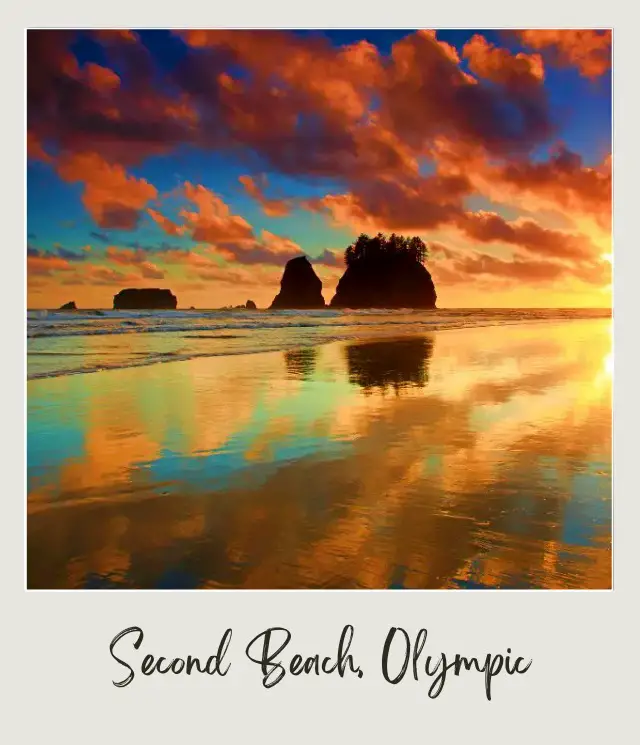
What You Need To Take/ Wear to Second Beach, Olympic National Park, WA
1. I recommend taking a rain jacket and wearing layers that you can take off or put on depending on the weather, which can change throughout the day. If you need one, I like this Columbia rain jacket for men and this Little Donkey Andy rain jacket for women.
2. You will definitely want to take a camera. I love the GoPro HERO 12. It’s designed for travel. It’s water resistant and durable and takes photos, video and even does streaming. Check current prices on the GoPro HERO 12 here
3. Binoculars. Bald eagles and other birds are often seen here, so a good pair of binoculars will add to your experience. If you’re looking to buy some, check out my Guide to the Best Binoculars for the Money or pick up my top pick, these Vortex Diamondback HD 10×42.
4. Take water. I love this hydroflask. It’s easy to carry, keeps temperatures well, and comes in multiple colors.
5. Shoes or boots suitable for walking on rocks (that you may get wet) as well as hiking in the forest. The trail to the beach has a lot of tree roots. Then, when you’re at the beach, if you’re visiting at low tide, you’ll want to explore the tidal rock pools, which involves walking on sharp rocks.
So, you’ll want to wear good hiking boots or shoes. If you need to get some, take a look at my Guide to Buying the Best Hiking Shoes/ Boots to help you know what to look for and get some recommendations. My top pick is this pair of Salomon Gore-Tex boots.
6. Check my list of essential things to take and wear on a day hike to make sure you have everything you need.
Camping at Second Beach, Olympic Peninsula
There are two options for Second Beach, La Push camping.
1. Mora Campground
For camping near Second Beach Washington, Mora Campground is your best option. It’s the nearest official NPS campground to Second Beach. Although it’s a 10-minute drive away, it’s the closest thing there is to a Second Beach family campground.
I’ve stayed here and it’s a nice campground with sites for tents and RVs set amongst trees. There is a reservation system in effect for late May to late September. There are 94 sites available and you can book on recreation.gov. The rest of the year, it is first come, first-served.
Each campsite has a fire ring (with a fire grate) and picnic table. Potable water and flush toilets are located throughout the campground. No electrical hookups are available at any campsites, but there is a RV dump station available (summer only) for $10 fee ($5 for Senior or Access Passes).
2. Camping on Second Beach, La Push, Washington
If you enjoy or would like to try beach camping, Second Beach is a great place. You can camp anywhere along the beach, but of course, as with all the beaches, you need to make sure you’re above the high tide line, which means you’ll be close to the edge of the beach.
Wilderness Camping Permits are required for La Push Second Beach camping. Overnight permits can be obtained on the NPS.
You can make your reservations here at the National Park Service website for a Second Beach campground / permit. Click on the “South Coast” and then “Second Beach”.
Read more about Olympic National Park Wilderness Backpacking Reservations .
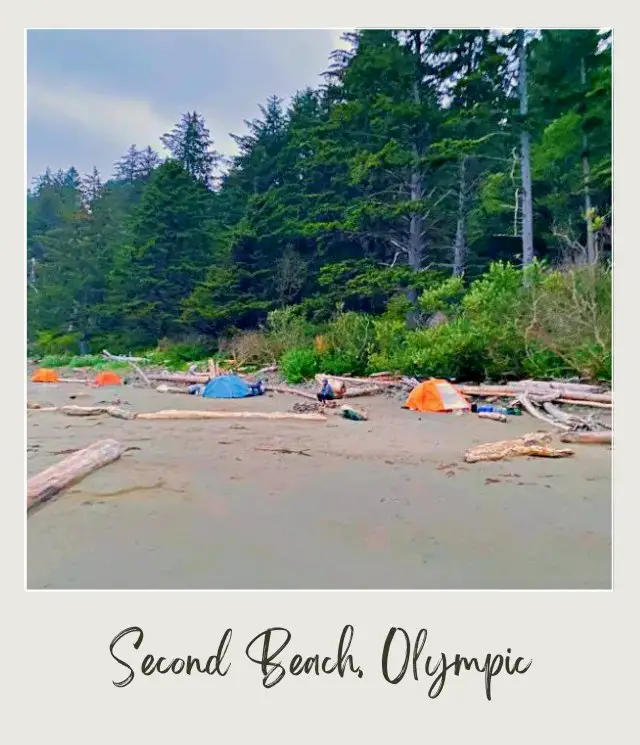
If you want to do this, a few things to keep in mind:
‼️You need to obtain a backcountry permit for camping on the beach.
‼️All food, garbage, and scented items MUST be stored in hard-sided containers like bear canisters (raccoons are a problem). You can get some ultra-lightweight ones here.
‼️Be sure to set up your tent above the high-water mark (which is very close to the edge of the beach).
‼️If you’re looking to get a tent, check my Guide to the Best Beach Camping Tents before you make a final decision.
‼️You can use driftwood found on the beach to create a fire
‼️Although once you get to the beach, you can find a spot to pitch your tent nearby, it is a 0.7-mile hike to get to the beach, so you’ll need to be able to carry all your gear with you.
‼️Check my Beach Camping Packing List to make sure you have all you need
➡️ If this is your first time beach camping, check out my 20 Beach Camping Tips for First Timers
Lodging Near Second Beach, Olympic National Park, Washington
Second Beach is very close to La Push, though accommodations are very limited there. It’s an hour and 15 minutes to Port Angeles, which is less convenient, but still possible.
The most convenient place to stay nearby is Forks. It’s just 15 minutes away and there is a range of accommodations, plus several restaurants to choose form.
LUXURY OPTION: Misty Valley Inn
Not a typical luxury hotel, but a really lovely Bed and Breakfast, this is a really nice option in and near Forks. It has a lovely setting and a porch where you can enjoy the views. Some rooms have private decks. It’s about 5 minutes outside Forks, but just two minutes to La Push Road. A full English/ Irish breakfast is included. Rooms all have private bathrooms, AC and free WiFi. There’s also a large shared family room where you can relax on cooler days or at night.
➡️ Check availability for Misty Valley Inn
MID-RANGE OPTION: Woodlands Inn
Located in Forks, this inn has very comfortable cabins with porches in a pleasant setting. Each cabin features a patio, a fully equipped kitchen with a microwave, a fireplace, a seating area with a sofa, a flat-screen TV and a private bathroom with shower and a hairdryer. There are several bed configurations offered.
➡️ Check availability for Woodlands Inn
BUDGET OPTION: Pacific Inn Motel
Located in Forks, this motel is a comfortable, clean option at a more affordable price. Rooms have private bathrooms, free WiFi, a flat-screen TV and air conditioning. Some rooms have private balconies and family rooms are offered.
➡️ Check availability at Pacific Inn Motel
Second Beach Tide Charts
Although you can walk along part of the beach at high ride, you may find yourself doing more scrambling over driftwood than strolling along the beach. So, I recommend visiting at low tide. Plan to arrive at Second Beach at least 30 minutes before the lowest tide.
I recommend checking the official tide chart here when you are planning your trip so you can visit at the right time.
When you look at the tide chart, you may notice that some low tides are ‘negative tides’ meaning that they go below sea level. The negative tides are best for tide pooling, as the water levels are the lowest. However, regular low tides are fine.
Weather at Second Beach, La Push, WA

Summer is by far the most popular time to visit the Olympic Peninsula and this is also when the weather is by far the best. There’s a lot less rain in summer, though rain and thunderstorms are possible at any time and it can be foggy on the coast even on sunny days. Temperatures are mild. August is the warmest month of the year, but even then, average temperatures are between 53.1°F and 64.8°F.
Winter is by far the wettest season. This is when the region gets the bulk of the rain – and it is a LOT of rain. Temperatures are surprisingly mild, though. The coldest month is December, with an average low-temperature of 40.6°F and an average high-temperature of 45.5°F.
Spring and Fall are similar but opposite. In spring, the temperature is rising and the rainfall is decreasing, while in fall, temperatures are falling and rainfall is increasing.
September is a lovely month with still very mild temperatures and not too much rain, but the other months are a mixed bag, with unpredictable weather.
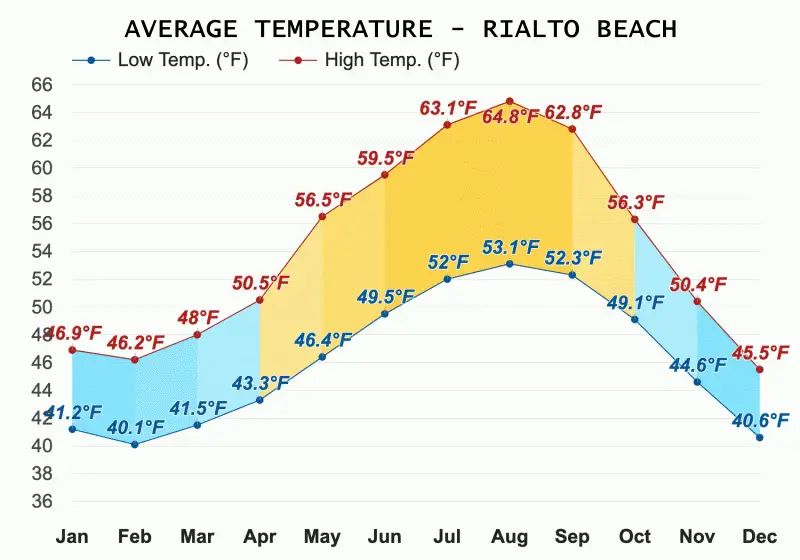
Directions to 2nd Beach
Here are directions to Second Beach from key departure points:
Forks to Second Beach
Follow WA-101 north from Forks for 1.5 miles. Turn left onto La Push Road (WA-110). After 13 miles (about 15 minutes), you’ll see a sign for Third Beach and a parking lot on your left. It’s a short distance after Third Beach.
Port Angeles to Second Beach
From Port Angeles, drive US-101 west for 55 miles. Turn onto WA-110 West (La Push Road). After 11.5 miles (about 15 minutes), you’ll see a sign for Third Beach and a small parking on your left. If you come to Second Beach, you’ve gone too far. After 13 miles (about 15 minutes), you’ll see a sign for Third Beach and a parking lot on your left. It’s a short distance after Third Beach.
Hoh Rainforest to Second Beach
Take Hoh Valley Rd/Upper Hoh Rd for 18 miles back to WA-101. Turn right and take WA-101 north for 14.6 miles. Drive through Forks. Another 1.5 miles from the center of Forks, take the turn off to La Push Road (WA-110) on your left. After 13 miles (about 15 minutes), you’ll see a sign for Third Beach and a parking lot on your left. It’s a short distance after Third Beach.
Seattle to Second Beach
There are two main routes from Seattle to Second Beach.
The northern route heads out from Seattle to the Seattle – Bainbridge Ferry to Bainbridge Island. Check ferry times here. Then get on WA-3 N in Poulsbo from WA-305 N. Follow WA-104 W and US-101 N for 113 miles through Port Angeles to WA-110 W/La Push Rd in Forks. Turn right onto La Push Road. After 13 miles (about 15 minutes), you’ll see a sign for Third Beach and a parking lot on your left. It’s a short distance after Third Beach. This trip takes a little under 4 hours, though travel times varies with the ferry schedule and traffic.
The southern route is a little longer. Head south from Seattle to Tacoma. Follow I-5 S, WA-8 W and US-12 W to 95190/Wynoochee Valley Rd in Grays Harbor County. Take the exit toward Devonshire Road from US-12 W. Continue on 95190/Wynoochee Valley Rd. Take 51800/Wynooche Wishkah Rd to US-101 N. Turn right onto US-101 N and follow 101 north for 91 miles, driving through Forks. Another 1.5 miles from the center of Forks, take the turn off to La Push Road (WA-110) on your left. After 13 miles (about 15 minutes), you’ll see a sign for Third Beach and a parking lot on your left. It’s a short distance after Third Beach. This route typically takes a little over 4 hours but doesn’t require a ferry.
➡️ Book a rental car through Discover Cars
FAQS about Second Beach, Forks, WA
Where is Second Beach, Washington?
Second Beach lies near the end of La Push Road, a short distance before the small village of La Push.
Are dogs allowed at Second Beach?
No, dogs are not permitted on Second Beach.
Can you camp on Second Beach Washington State?
Yes, you can camp overnight on Second Beach, but you need to get a wilderness permit from the National Park Service first.
Do you need a permit to camp at Second Beach?
Yes, you need a wilderness permit, which you can get online. Select “South Coast” and then “Second Beach”.
Is visiting Second Beach worth it?
Yes! Second Beach is considered of the jewels in Olympic National Park’s crown. When you emerge from the forest and first see the sandy beach, large sea stacks, piles of driftwood and natural arch, it will take your breath away!
How long is the trail to Second Beach?
The hike to Second Beach is 0.7 miles each way and takes about 20-30 minutes each way.
Are there bathrooms at Second Beach?
Yes, there are restrooms at the trailhead to Second Beach.
Is there parking at Second Beach?
Yes, there are 10 parking spaces at the Second Beach Trailhead plus a large overflow parking lot nearby.
If you’re planning to visit Olympic National Park by yourself, make your planning easy and stress free with a detailed itinerary. I have 1-, 2-, 3- and 4-day itineraries for Olympic National Park that include all the park highlights, give you choices based on your preferred activity level, and take all the stress out of planning your trip.
Travel Insurance for Olympic National Park
Whether you’re visiting Second Beach for a day or camping overnight, you should definitely get travel insurance. This can protect you not only against medical and emergency repatriation, but can also cover things like trip cancellation, loss and/ or theft of property, etc.
➡️ A great insurance option is Travelex. It has coverage for all you’ll need. You can choose the best travel insurance plan for your trip here or get a quote right now:
Enjoy Second Beach!
More Planning Resources for Olympic National Park
⭐ Olympic National Park Guide
⭐ Olympic National Park Itinerary
⭐ 7 Mistakes to Avoid in Olympic
⭐ How Many Days in Olympic National Park?
⭐ Packing List for Olympic National Park
⭐ Best Things to Do in Olympic National Park
⭐ Best Views In Olympic National Park
⭐ Best Waterfalls in Olympic National Park
⭐ Best Hikes in Olympic National Park
⭐ Visiting Hurricane Ridge: Complete Guide
⭐ Best Hurricane Ridge Hikes
🔹 Hurricane Hill Trail Guide
🔹 Cirque Rim Trail Guide
🔹 High Ridge Trail to Sunrise Point Trail Guide
⭐ Best Hikes Near Lake Crescent
🔹 Marymere Falls Trail Guide
⭐ Best Sol Duc Hikes
🔹 Sol Duc Falls Trail Guide
🔹 Ancient Groves Nature Trail Guide
🔹 Sol Duc Salmon Cascades
⭐ Best Hoh Rainforest Hikes
🔹 Hall of Mosses Trail Guide
🔹 The Hoh River Trail Guide
⭐ Best Olympic National Park Beaches
⭐ Best Tide Pools in Olympic National Park
🔹 Rialto Beach Guide
🔹 Kalaloch Beach 4 Guide
🔹 Third Beach Guide
🔹 The Tree Of Life
⭐ Best Lake Quinault Hikes
🔹 Maple Glade & Kestner Homestead Trails
⭐ Lake Quinault Loop Drive: A Complete Guide
⭐ 12 Tips for Visiting Olympic National Park
⭐ How To Get to Olympic National Park
⭐ All The Airports Near Olympic National Park
⭐ The Closest Airport to Olympic National Park
⭐ The Best Time To Visit Olympic National Park
⭐ What To Expect Throughout the Year
⭐ 10 Fun Facts About Olympic National Park
Do you have any tips for visiting Second Beach in Olympic National Park or questions about it, I’d love to hear about them. Join my private Facebook group National Parks Collectors and comment and let me know (you can also pick up extra planning tips, share your photos and stories with other national park lovers and more).
Subscribe to daily national parks planning tips, travel inspiration and trip ideas and get instant access to the free PDF of the
La Push Second Beach, Washington State: Complete Guide
If you liked this article, Pin It to your Olympic National Park board!

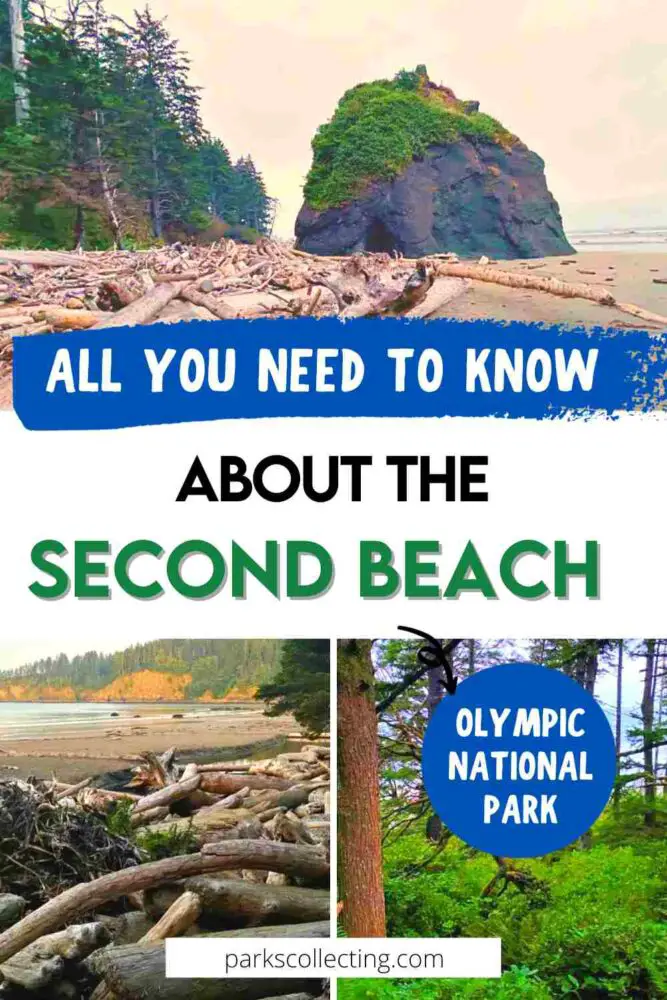
💡 Are you just starting to think about taking a national parks trip? Get Inspiration
‼️ Are you looking for helpful tips for visiting US national parks? Read articles that share useful tips on a range of national-park related issues
💻 Are you starting to plan a trip to Olympic National Park? Read my Guide to Olympic National Park
📋 Do you want a ready-made super detailed plan for your trip to Olympic? Get a detailed 1 – 4-day Olympic National Park Itinerary
💲 Are you ready to book your trip? Use these Planning and Booking Resources
📖 Do you want to read a book about US national parks? Check out my Recommended Reading Lists
About the Author
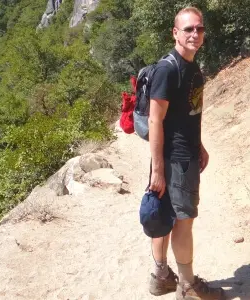
James Ian is a national park, camping and hiking expert.
He has dedicated his life to travel, visiting more than 80 countries, all 7 continents and most of the national parks in the United States. With over 35 years experience in the travel industry, James has worked on cruise ships, at resorts and hotels, and as a travel planner who’s helped hundreds of people plan successful trips to US national parks.
Based on his experience visiting our national parks multiple times, in-depth research and expertise as a travel planner, James has published detailed itineraries for many of the major national parks in the US. These itineraries, as well as in-depth park guides, and other resources will help you have your own incredible trip to US national parks without stress and hassle.
As a national park expert, James has contributed to many publications, including USA Today, Newsweek, Time Business News, Savoteur, Best Trip, and Wired.
I’m a member of the Amazon Services LLC Associates Program. As an Amazon Associate I earn from qualifying purchases.



